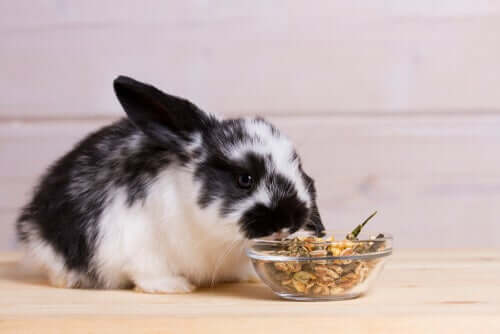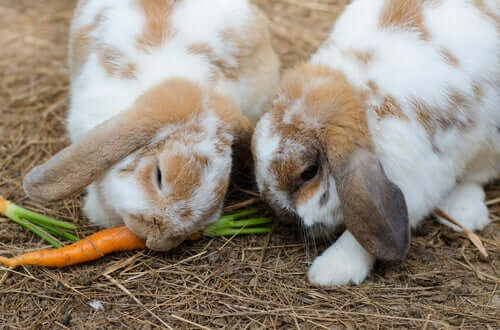How Much and When Rabbits Should Eat


Written and verified by the biotechnologist Alejandro Rodríguez
Mealtime is one of the most yearned-for moments for our pets. Rabbits especially enjoy eating, even more so when their diet includes their favorite foods. For that reason, it’s important to pay special attention to their nutritional guidelines. To help you out, we’ll share some advice so you know when and how much rabbits should eat.
Rabbits and nutrition
Before planning your rabbit’s diet, it’s always a good idea to remember the biological history of rabbits. Up until the beginning of the 20th century, their similarity to rodents led us to believe that rabbits belonged to the Rodentia order. However, later studies demonstrated that rabbits and their kind are actually lagomorphs. In other words, they belong to a completely different order to rodents.
Specifically, rabbits are part of the Leporidae family, to which hares and other species also belong. All of these animals have certain characteristics in common: their strong back legs, large ears, and two rows of incisor teeth. However, the shared characteristic that most interests us is their herbivore diet.
If you have a rabbit in your home, there are several things you should know. First of all, rabbits need a varied diet. What’s more, there are some things that are fundamental, such as:
- Hay: This is an essential food when it comes to the proper development of rabbits. Fresh hay provides fiber and helps their digestive system. It also helps wear down their teeth.
- Fresh vegetables: Fresh veggies are also important, although we should offer a lower proportion. Leafy greens like chard, carrot tops, and watercress are examples of vegetables that rabbits should eat.
- Fruits: It’s nice to treat them to fruit every once in a while.
- Rabbit food: Owners should offer rabbit food, which usually comes in pellet form, as a complement to the main meal. In other words, rabbit food should not be your pet’s main source of nutrition.

How much should rabbits eat?
When it comes to how much rabbits should eat, it’s difficult to provide a precise answer. This is because there are a series of variables, like the animal’s age and level of development. In general, the amount varies especially according to the type of food in question. When it comes to newborns, a diet based on maternal milk or similar is ideal.
Hay should make up 70% of your rabbit’s diet. However, you shouldn’t offer rabbits hay until they are a month and a half old. The hay should be high quality. Furthermore, if possible, change the hay often to make sure your rabbit always has fresh hay available.
The vegetables that rabbits should eat need to be moderately rationed. If you have a young rabbit in your home (older than 6 months), then vegetable rations should not be more than 10% of your pet’s body weight.
You should offer fruit and rabbit food in small portions. More specifically, be sure not to offer more than 3 ounces to adult rabbits. Remember that these foods should only supplement your animal’s regular diet.

When should rabbits eat?
As a general rule, rabbits should eat twice a day. However, once again, there are several factors to consider when establishing a precise frequency. Among these factors, a rabbit’s age is the most relevant.
When it comes to baby rabbits, you should offer milk at least three times a day. As your pet grows, you should begin to vary the diet as well as frequency.
For example, you should divide vegetable rations over two feedings when rabbits are still young. At the same time, adult rabbits can eat their entire vegetable ration in one feeding. As mentioned above, fruit should be an occasional treat. We recommend establishing a weekly amount–for example, three times a week.
However, things like hay and water should be available at all times. What’s more, you should always make sure that the hay and water are fresh, and change them often.
Mealtime is one of the most yearned-for moments for our pets. Rabbits especially enjoy eating, even more so when their diet includes their favorite foods. For that reason, it’s important to pay special attention to their nutritional guidelines. To help you out, we’ll share some advice so you know when and how much rabbits should eat.
Rabbits and nutrition
Before planning your rabbit’s diet, it’s always a good idea to remember the biological history of rabbits. Up until the beginning of the 20th century, their similarity to rodents led us to believe that rabbits belonged to the Rodentia order. However, later studies demonstrated that rabbits and their kind are actually lagomorphs. In other words, they belong to a completely different order to rodents.
Specifically, rabbits are part of the Leporidae family, to which hares and other species also belong. All of these animals have certain characteristics in common: their strong back legs, large ears, and two rows of incisor teeth. However, the shared characteristic that most interests us is their herbivore diet.
If you have a rabbit in your home, there are several things you should know. First of all, rabbits need a varied diet. What’s more, there are some things that are fundamental, such as:
- Hay: This is an essential food when it comes to the proper development of rabbits. Fresh hay provides fiber and helps their digestive system. It also helps wear down their teeth.
- Fresh vegetables: Fresh veggies are also important, although we should offer a lower proportion. Leafy greens like chard, carrot tops, and watercress are examples of vegetables that rabbits should eat.
- Fruits: It’s nice to treat them to fruit every once in a while.
- Rabbit food: Owners should offer rabbit food, which usually comes in pellet form, as a complement to the main meal. In other words, rabbit food should not be your pet’s main source of nutrition.

How much should rabbits eat?
When it comes to how much rabbits should eat, it’s difficult to provide a precise answer. This is because there are a series of variables, like the animal’s age and level of development. In general, the amount varies especially according to the type of food in question. When it comes to newborns, a diet based on maternal milk or similar is ideal.
Hay should make up 70% of your rabbit’s diet. However, you shouldn’t offer rabbits hay until they are a month and a half old. The hay should be high quality. Furthermore, if possible, change the hay often to make sure your rabbit always has fresh hay available.
The vegetables that rabbits should eat need to be moderately rationed. If you have a young rabbit in your home (older than 6 months), then vegetable rations should not be more than 10% of your pet’s body weight.
You should offer fruit and rabbit food in small portions. More specifically, be sure not to offer more than 3 ounces to adult rabbits. Remember that these foods should only supplement your animal’s regular diet.

When should rabbits eat?
As a general rule, rabbits should eat twice a day. However, once again, there are several factors to consider when establishing a precise frequency. Among these factors, a rabbit’s age is the most relevant.
When it comes to baby rabbits, you should offer milk at least three times a day. As your pet grows, you should begin to vary the diet as well as frequency.
For example, you should divide vegetable rations over two feedings when rabbits are still young. At the same time, adult rabbits can eat their entire vegetable ration in one feeding. As mentioned above, fruit should be an occasional treat. We recommend establishing a weekly amount–for example, three times a week.
However, things like hay and water should be available at all times. What’s more, you should always make sure that the hay and water are fresh, and change them often.
All cited sources were thoroughly reviewed by our team to ensure their quality, reliability, currency, and validity. The bibliography of this article was considered reliable and of academic or scientific accuracy.
- Blas, C., & Wiseman, J. (Eds.). (2010). Nutrition of the Rabbit. CABI.
- Carabaño, R., Rebollar, P. G., Gómez-Conde, M. S., Chamorro, S., García, J., & de Blas, C. (2005). Nuevas tendencias en la alimentación de conejos: Influencia de la nutrición sobre la salud intestinal. XXI Curso de Especialización FEDNA. Madrid, España, 113.
- Gidenne, T. (2003). Fibres in rabbit feeding for digestive troubles prevention: respective role of low-digested and digestible fibre. Livestock Production Science, 81(2-3), 105-117.
- Brown, S. (2012). Rabbit Diet. Recuperado el 11 de agosto de 2022, disponible en: https://www.oakhurstvet.com/userfiles/Rabbit%20Diet.pdf
This text is provided for informational purposes only and does not replace consultation with a professional. If in doubt, consult your specialist.








